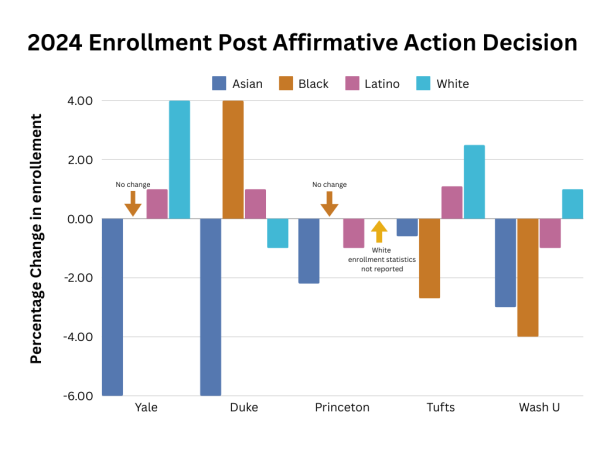Since before affirmative action was struck down in June 2023, Asians have been at the center of a cultural war. Now, new admissions data released in July suggests that the anti-affirmative action movement used Asian students to reinforce a predominantly white status quo in college admissions.
Affirmative action is the practice of employing policies that remedy the results of prior discrimination and disadvantage among certain minorities in the admission process. This primarily is on the basis of race and ethnicity. The term was first introduced in 1961, when President Kennedy created a Committee on Equal Employment Opportunity and issued Executive Order 10925, which used the term “affirmative action” to refer to measures designed to achieve non-discrimination.
Opponents of affirmative action believe that it unfairly favors certain – primarily Black and Latino – applicants over more qualified competitors of different ethnic backgrounds and that it is unfair or unethical to use race as a consideration in the admissions process. Proponents, meanwhile, believe that because some applicants have been historically disadvantaged and therefore provided fewer opportunities, it is not possible to compare solely based on the academics and achievements that wealthier – and oftentimes white – applicants have access to, such as exam tutoring, internship and research opportunities.
During the lawsuit by Students for Fair Admission that led to affirmative action being overturned, however, the loudest anti-affirmative action voices were oftentimes not white. They were Asian.

According to a study conducted by the Pew Research Center prior to the ruling, half of Asians polled who had heard of affirmative action believed it was a good thing, but only one in five said race or ethnicity should be factored into admissions decisions. However, following the ruling, Asian enrollment dropped at Yale, Princeton and Duke, where white enrollment increased. Asian American enrollment dropped to 29 percent from 35 percent at Duke; to 24 percent from 30 percent at Yale; and to 23.8 percent from 26 percent at Princeton. Other elite schools such as Tufts University, Washington University in St. Louis, and the University of Virginia also saw decreases in Asian American acceptance. (Black enrollment dropped at almost all institutions that released data, and Latino enrollment increased at some colleges while decreasing at others.)
Thus far, evidence shows that removing affirmative action hasn’t provided greater equality to Asians: instead, white enrollment has increased at their expense. This stark decline in Asian American enrollment at prestigious institutions, alongside the lack of support for affirmative action in the Asian community, highlights the pitfalls and dangers of the model minority myth.
The model minority myth posits that Asian Americans, unlike other ethnic groups, have succeeded due to their hard work and merit. The stereotype suggests that, as a result, there is little or no need for social or economic assistance for the same or different minority groups. In truth, Asian Americans are the most economically divided racial or ethnic group in the U.S. These economic disparities are partially driven by similar disparities in education levels among Asian Americans. The highest-earning groups — Indian American and Taiwanese American households — also have the highest levels of education. Meanwhile the lowest-earning groups – Mongolian, Bangladeshi and Burmese Americans – have comparatively lower levels of education.
By championing Asian students as a counterpoint to affirmative action through the perpetuation of the model minority narrative, the varied experiences and socioeconomic challenges are erased and a narrow definition of success that aligns with predominantly white values is reinforced. White opponents of affirmative action effectively co-opted Asian students as political pawns, using the experiences of some more privileged Asians to argue against affirmative action without addressing the broader context of racial and economic disparity.
There’s a saying that goes like this: when you’re accustomed to privilege, equality feels like oppression. The ultimate consequence of the end of affirmative action is the reinforcement of a status quo that disproportionately benefits white students – a step backwards for creating equitable admissions for all.